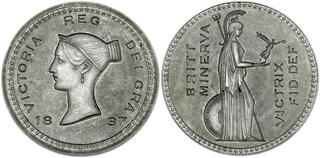| Ira & Larry Goldberg Coins & Collectibles > Auction 137 | Auction date: 29 January 2024 |
| Lot number: 1157 Price realized: 17,500 USD (Approx. 16,209 EUR) Note: Prices do not include buyer's fees. | Show similar lots on CoinArchives Find similar lots in upcoming auctions on |
| Lot description: Great Britain. Pattern Bonomi Crown, 1837. ESC-2617 (R3) (323A). Victoria, 1837-1901. Struck in Aluminum. Plain edge, no number. Obverse; Incuse portrait of Queen Victoria left. Reverse; Britannia standing. Very attractive specimen. Extremely Rare. PCGS ID#945759.63 does not appear on the Pop Report. Our piece is probably the only example graded at PCGS. PCGS graded Proof 63. Estimated Value $4,000 - UP The famous 1893 incuse-design piece which was a mystery to collectors for some years when it first appeared on the market. To some extent, it remains mysterious. Known in a variety of metals, with a total mintage among them probably in the range of 200 to 300 pieces, this "pattern" was apparently the invention of a gentleman named Joseph Bonomi. The story is well told in Linecar & Stone's book, derived from an article in the Numismatic Circular by Captain Pridmore. Bonomi it seems was an Eqyptian traveler and antiquarian, member of the Numismatic Society of London in 1837, who believed that coins would wear less if their design were incuse, rather than raised, an idea that would take form in American gold quarter eagles and half eagles starting in 1908, by designer Bela Lyon Pratt. Bonomi supposedly conceived the Queen and Britannia in a style that suggested an Egyptian motif, which of course was extremely popular in the 1830s. How the master dies were created, and exactly when and by whom, remains indefinite. However, dies were sunk by Theophilus Pinches (probably in 1893) and coins offered for sale in May 1893 by Rochelle Thomas. It is from the latter's ad offering these for the first time that most of what we know about them comes. However, he took license with certain facts to make them more desirable. ESC lists the various metals in which this piece was struck. Those that were numbered bear a number on their edge of from 1 to 150. Whatever is the truth behind these curious coins, and when precisely they were made (1887 to 1893 or even afterwards), is of little consequence today. They are accepted among the patterns of Queen Victoria by most collectors simply because of their stark beauty. Most specimens are not very well preserved, unfortunately. The present crown is among the finest seen by the cataloguer, bright and "fresh." In our opinion, the grading service did not understand the striking procedure of this pattern and the grade assigned should have been somewhat more generous. This is a rare opportunity to acquire one of the more alluring Victorian numismatic items, something very few collectors indeed can claim among their holdings. Extremely rare, and very desirable! Ex Spink, London, May 2005. |  |


